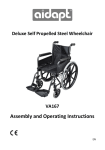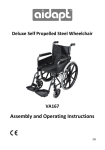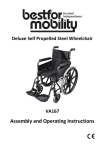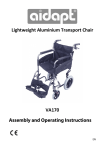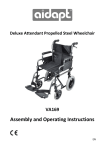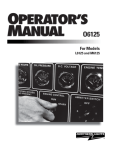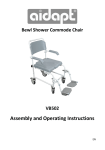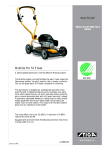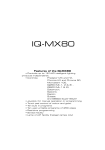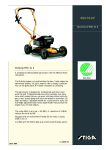Download Assembly and Operating Instructions
Transcript
Deluxe Self Propelled Steel Wheelchair VA167 Assembly and Operating Instructions EN This file is available to view and download as a PDF at www.aidapt.co.uk. Sight impaired customers can use a free PDF Reader (such as adobe.com/reader) to zoom in and increase the text size for improved readability. READ BEFORE USE Before using your new Wheelchair, you and each person that may assist you in its use should take time to read this manual and follow all instructions. INTRODUCTION Thank you for purchasing your wheelchair from Aidapt. This model has been designed to help you gain independence and meet your particular requirements. Throughout the manufacturing process, great care has been taken; the components have been selected by quality and inspections carried out to ensure you get full satisfaction from our product, including BS EN12183 2009. PLEASE NOTE: Your Wheelchair has a unique identification serial number. This is located on the main cross brace below the seat canvass and should be used in all correspondence. Write your serial number here for future ref: ……………………………………… Model VA167 can be wheeled by the person sitting in the wheelchair and also feature pram handles for assistance pushing. The maximum user weight is 115 kg; under no circumstances should this be exceeded Before each use please take the time to check your Wheelchair for any loose parts. Any modification to this product without the express permission from Aidapt will invalidate your guarantee. Assembly and Operating Instructions Ver. 4 01/14 (2286) 2 SAFETY SUMMARY The following recommendations are made for the safe use of the wheelchair. NOTE: Do not assemble or use this equipment without first reading and understanding this instruction manual. If you cannot understand the instructions, please contact Aidapt, a Healthcare Professional or a Dealer before installing this equipment. • Before using this product, care must be taken to ensure that fitments are secure, the castors/wheels are in good working order, the wheelchair is properly balanced and all wheels must be in contact with the floor at all times during use. • For safe operation, the following points must be remembered: i. Always observe the limits regarding reaching objects, leaning back, tilting and use of manual brakes, tyres and weights limits. These are dealt with under the section headed Assembly and Use. ii. The footplates are designed only to support the feet while in the seated position. DO NOT STAND ON THE FOOT PLATES. iii. The upholstery meets the flammability requirements of the California Bureau of home furnishings technical bulletin 117. Care should be exercised near open flames or burning cigarettes. iv. WARNING: Surface areas of your Wheelchair can get hot when the wheelchair is exposed to external sources of heat (eg. sunlight). • Please now refer to the section on Assembly and use. Assembly and Operating Instructions Ver. 4 01/14 (2286) 3 ASSEMBLY 1. First remove all contents from the box. 2. To open the wheelchair, push seat rails and press downwards until the chair is fully opened taking care to keep fingers clear of moving parts (Fig. 1). 3. To close the wheelchair, take the centre of the seat fabric at the front and back edges and lift (Fig. 2). Note: The seat rails must be fully engaged in the seat frame support brackets before sitting down. Fig. 1 Fig. 2 Note: When opening and closing your Wheelchair please keep fingers well away from any possible entrapment areas. The only part of the Wheelchair that can be adjusted are the leg rests. Ideally your knees should be at 90 degrees with the seat. If you are not sure please contact a healthcare professional or your local Wheelchair dealer for advice. Assembly and Operating Instructions Ver. 4 01/14 (2286) 4 BRAKE OPERATION Parking Brakes (Occupant) See Fig. 7 which shows the wheelchair with the parking brake not applied. To apply the parking brake push the handle forward as in Fig. 7a until it ‘clicks’ and this will apply the brake. Fig. 7 Fig. 7a BRAKE ADJUSTMENT To adjust the brakes, release the two hex nuts with an alan key and slide the brake unit forwards/backwards. When the brake is adjusted as required re-tighten the hex nuts. See Fig. 7b. Hex nuts Fig. 7b Assembly and Operating Instructions Ver. 4 01/14 (2286) 5 USE WARNING: The centre of balance is affected by a change in posture body position or weight distribution. Many activities require the wheelchair owner to reach, bend and transfer into and out of the wheelchair. These movements will cause a change to normal balance, centre of gravity and weight distribution of the wheelchair. The design of your wheelchair enables it to remain stable for normal everyday usage if used correctly in accordance with the recommendations in this manual. 1. Reaching/bending forward Move the wheelchair as close as possible to the object you wish to reach. Position the front castors so that they are extended as far forward as possible. Fully engage the wheel locks on the rear wheels. Only reach out to take what is within arm’s length in normal sitting position. Only the arms should extend beyond the seat of the wheelchair. 2. Reaching/bending backwards Move the wheelchair as close as possible to the object you wish to reach. Reach back only as far as your arm will extend without changing your seating position. Do not lean over the top of the back upholstery as this could change your centre of gravity and may cause you to tip over. 3. Reaching/leaning sideways Move the wheelchair as close as possible to the object you wish to reach. Rotate the front castors to a line in the direction you will be reaching. Fully engage the wheel locks on the rear wheels. Do not shift your weight or sitting position towards the object you are reaching as it may cause the wheelchair to tip over. 4. Transferring Before attempting to transfer in and out of the wheelchair, every precaution should be taken to ensure the gap between the two seats is as small as possible. Be certain that the wheel locks are on to prevent the wheels moving. Turn both castors in the direction of the seat to which you wish to move. Lift up the footplates and fold back the supports to the side. Do not stand on the footplates. It is imperative that the actual transfer procedure be supervised by a certified health care professional until the wheelchair owner is familiar with the procedure. Assembly and Operating Instructions Ver. 4 01/14 (2286) 6 5. Negotiating Obstacles 5.1 Forwards The wheelchair should be tilted by the helper until the front castors have passed over the kerbs. Move the wheelchair forward until the rear wheels touch the kerb and gently lower the front castors over the pavement. Push the lift until the rear wheels have mounted the kerb. The wheelchair should not be lifted by the handles alone. 5.2 Backwards The wheelchair should be positioned so that the rear wheels are against the kerb. The helper should then tilt the wheelchair backwards and then pull the chair until the rear wheels mount the kerb. The front castors should only be lowered to the ground when the wheelchair has been pulled sufficiently away from the kerb. 5.3 Upward and Downward slopes Always go straight up and down slopes to avoid the possibility of the wheelchair overturning. Avoid steep slopes, which may cause instability. Assembly and Operating Instructions Ver. 4 01/14 (2286) 7 AIDAPT GENERAL TRANSPORT GUIDANCE The design of your wheelchair enables it to remain stable for normal everyday usage if used correctly in accordance with the recommendations in this manual. Use as a Seat in Transport Aidapt recommend that when possible, wheelchair users should transfer from their wheelchair to a vehicle seat and use a 3-point occupant restraint system for the seated position. Aidapt also recognises that due to reason of pain or discomfort, transfer may not be possible. The VA167 wheelchair chair has been successfully tested according to the requirements of ISO 7176 Part 19: Wheelchairs for Use in Transport, using a 4-point tie-down and occupant restraint system from the range of ISO 10542-1 compliant equipment developed and supplied by Unwin Safety Systems. Aidapt recommends the use of transport equipment supplied by Unwin Safety Systems, their contact details are as follows - Website: www-unwin-safety.com, Tel: +44 1935 827740. Information regarding the location of tie-down attachment points are provided in Fig 8 and Fig 9 below. Front fixing points Rear fixing points Fig 8 Fig 9 Assembly and Operating Instructions Ver. 4 01/14 (2286) 8 Transport – General Instructions When transfer to a vehicle seat is not possible, the following General Recommendations are made: 1. Ensure that the wheelchair is correctly maintained and that settings of any adjustable parts are made according to manufacturers ‘Instruction for Use in Transport’. 2. Remove any items of luggage that may be attached to the wheelchair and secure or store separately during transport in order to reduce the potential for injury to others passengers travelling in the vehicle. 3. Extra care must be exercised when using vehicle boarding aids such as passenger lifts or ramps during the loading process. Refer to Wheelchair manufacturers Instructions for Use for information on safe slopes. 4. Position the wheelchair facing forward - centrally in the designated region of the vehicle. Ensure the wheelchair brakes are applied. 5. To minimise the potential for head injuries in an impact, allow a clear space of at least 400 mm behind and 650 mm in front of the head of the wheelchair user. The shoulder belt anchorage must be side-wall anchored at a height level with or above occupant shoulder level. 6. A height provision ranging from 1200 mm to 1550 mm should be made, depending on the size of the passenger. There should also be 200 mm of clear space either side of the wheelchair. If these clear space dimensions cannot be provided then any structure protruding into this space should be adequately padded. 7. Postural support belts are not to be used as occupant restraints. 8. Wheelchair users, their carers and family are advised to check vehicle specifications to ensure that sufficient floor space is available to accommodate the wheelchair and tie-down system. Users of heavy powered wheelchairs are also advised to check vehicle carrying capacity. If in doubt consult vehicle supplier for further details. Assembly and Operating Instructions Ver. 4 01/14 (2286) 9 GENERAL DESCRIPTION The following diagram shows details of the wheelchair terminology used in this manual. VA167: Deluxe Self Propelled Steel Wheelchair Assembly and Operating Instructions Ver. 4 01/14 (2286) 10 GENERAL DESCRIPTION ctd. 1. Backrest There are two types of backrest fitted to the wheelchair, either fixed or adjustable. The adjustable backrest can be folded down by means of a locking mechanism fitted to both sides of the lower part of the backrest pillars. To fold the backrest down, push on both of the black plastic levers, then pull back and down on the top part of the backrest. To return to the original, reverse the procedure, making sure the mechanisms are locked securely. 2. Handles The handles are designed for the helper to propel the wheelchair. They must not be used solely for lifting the wheelchair over obstructions or kerbs (see negotiating obstacles) 3. Armrest PVC pads are fixed onto the armrest for comfort and can be replaced as spare parts. 4. Seat Upholstery Periodically check the upholstery for signs of tears or sagging. Replace immediately if the seat is damaged. Remember: the seat upholstery is the primary weight – supporting material. 5. Footplates The footplates are intended as a foot support only when you are sitting in the wheelchair. On no account should you stand on the footplates. The heel loops or calf straps (if fitted) can be used to secure the position of the feet. The footplate assemblies can be adjusted in height by loosening the nut of the base of the adjustment tube, positioning the plate at the required height and tightening the nut to secure the assembly. The footplate supports cannot be adjusted but are moveable from the wheelchair. They can be swung away to the outside of the wheelchair. To carry out this procedure, press the release lever and swing the support to the outside of the wheelchair. If the support is to be removed, lift it upwards. To re-fit and return to the original position, reverse the above procedure. 6. Castor and bearing The front wheels have solid puncture proof tyres. These should be checked at regular intervals to monitor any wear. Wheelchairs become difficult to steer and propel when surfaces have worn flat. It is recommended that both front tyres are replaced at the same time to avoid one side of the wheelchair from being higher than the other. Assembly and Operating Instructions Ver. 4 01/14 (2286) 11 The wheel is secured to the castor fork by an axle bolt and axle nut. Periodically, this bolt and nut should be checked and tightened if necessary to allow a snug but free spinning fit. The castor fork swivel allows the wheelchair to be steered. An adjustment locknut is located under the castor cap. If the locknut is too tight, the wheelchair will be difficult to steer. 7. Wheel lock assembly These are used to hold the wheelchair in a stationary position, and are fitted on either side of the wheelchair. They should not be used when the wheelchair is moving or to slow it down. They should always be applied together. To operate, push the brake lever forward towards the front of the wheelchair. This will immobilize the wheelchair. To release the brake, move the lever towards the rear of the wheelchair. 8. Cross Bar Operation of the cross brace permits the wheelchair to be opened and closed easily. It should be inspected at regular intervals for signs of wear and bending. 9. Folding Backrest Device Push down the hinge to fold down the backrest. Automatically lock when pull up the backrest handle. This device is to enhance the storage feature. 10. Quick Release Wheels To aid transportation, the rear wheels can be removed by pushing the middle section of the wheel and pulling to release. To refit, reverse the procedure. Always make sure the wheels are fully connected before use. Assembly and Operating Instructions Ver. 4 01/14 (2286) 12 ROUTINE CHECKS AND MAINTENANCE 1. Upholstery Upholstery should be routinely cleaned with a mild soap and water solution. Never use paint remover or thinners on upholstery. 2. Metal Parts Clean all metal parts with a wax compound such as car wash to maintain finish. Do not use any obtrusive cleanser that will scratch the finish on the chair. 3. Cross Brace Periodically lubricate the centre bolt on the cross brace with light machine oil. 4. Tyres and Wheels Examine tyres regularly for wear and replace as necessary. Solid tyres should be replaced when they become loose on the rim or cracks appear which expose the mounting wire groove. For pneumatic tyres, check tyre pressure is even and correct. Check that the wheels run freely and that quick release axles are correctly locked. If your wheelchair is fitted with pneumatic tires and you have a puncture please take your wheelchair to the nearest dealer or bicycle repair center 5. Castors Check periodically that the bolt and nut securing the wheel to the castor fork is tight and allows a snug but free spinning fit. 6. Brakes Regularly check for effective operation and there is no wear or signs of play. 7. General Always check before use that the wheelchair folds and unfolds correctly and that movement both backwards and forwards is in a straight line. 8. Servicing We recommend your wheelchair is fully serviced every twelve months. For parts and service information please contact Aidapt Bathrooms Limited (details on the back page). Your Wheelchairs has been made from the finest materials and tested to BS EN 12183:1999 for your complete piece of mind and the expected service life of your wheelchair is 5 years+. 9. Recycling of your Wheelchair Once the wheelchair has reached its expected service life you can contact Aidapt for disposal. Assembly and Operating Instructions Ver. 4 01/14 (2286) 13 SPECIFICATIONS ITEM Length (folded) Width (folded) Width (unfolded) Height Net weight Net weight (without leg rests/wheels) Maximum User Weight Seat size Colour Additional information DETAILS 31” (79 cm) 11½” (29 cm) 25” (63.5 cm) 29.5” (75 cm) 16.7 kg 10.35 kg 115 kg 46x40 cm Hammerite Quick release rear wheels Assembly and Operating Instructions Ver. 4 01/14 (2286) 14 GUARANTEE This product is warranted to be free of defects in materials and workmanship for a period of 5 years on the frame and 12 months on all other parts. The warranty is subject to the following conditions: 1. The purchaser shall complete the registration form below and send it to Aidapt Bathrooms Ltd within 14 days of purchase of the product, together with a copy of the sales invoice/receipt. 2. If any defect or fault is discovered, the supplier and/or Aidapt Bathrooms Ltd should be notified immediately. 3. Aidapt Bathrooms Ltd will not be responsible for damage caused by misuse, natural wear and tear, defective assembly or installation by the purchaser or their agent, defective treatments, unauthorised alteration to the equipment or use of unsuitable spares. 4. The purchases statutory rights under the Consumer Protection Act are not affected. Assembly and Operating Instructions Ver. 4 01/14 (2286) 15 Aidapt Bathrooms Ltd, Lancots Lane, Sutton Oak, St Helens, WA9 3EX Telephone: +44 (0) 1744 745 020 • Fax: +44 (0) 1744 745 001 • Web: www.aidapt.co.uk Email: [email protected] • [email protected] • [email protected] Assembly and Operating Instructions Ver. 4 01/14 (2286) 16
















